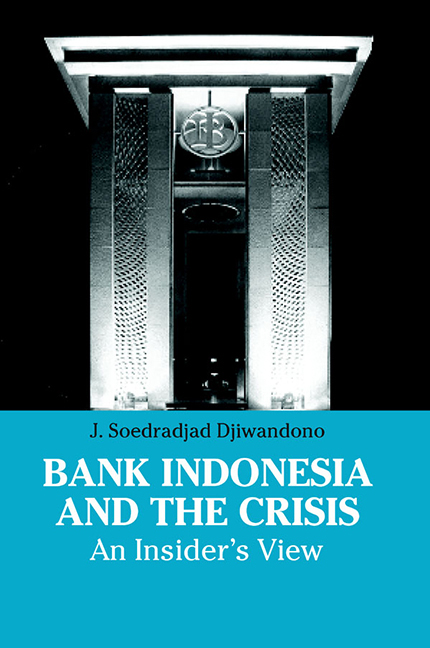Book contents
- Frontmatter
- Dedication
- Contents
- List of Tables
- Acknowledgements
- Glossary
- Prologue: The Crisis and Me
- 1 Introduction
- 2 Origin of the Crisis and Early Responses
- 3 Stabilization and Reform Programmes
- 4 Poor Programme Implementation
- 5 Stronger Programme with Weak Commitment
- 6 Bank Indonesia and the Crisis
- 7 Lessons from the Crisis
- 8 Epilogue
- Postscript
- Notes
- References
- Index
- About the Author
8 - Epilogue
Published online by Cambridge University Press: 21 October 2015
- Frontmatter
- Dedication
- Contents
- List of Tables
- Acknowledgements
- Glossary
- Prologue: The Crisis and Me
- 1 Introduction
- 2 Origin of the Crisis and Early Responses
- 3 Stabilization and Reform Programmes
- 4 Poor Programme Implementation
- 5 Stronger Programme with Weak Commitment
- 6 Bank Indonesia and the Crisis
- 7 Lessons from the Crisis
- 8 Epilogue
- Postscript
- Notes
- References
- Index
- About the Author
Summary
Caveat
Since the beginning, I have been confronted with a dilemma in the writing of this book. One motive for writing this book has been the wish to share with the public my observations, assessments as well as analysis about a crisis that has had an impact on all aspects of life in Indonesia. The crisis has been an extraordinary period for the Indonesian economy. However, due to my former position as one of the key players in the government, that strong wish has been clouded with an uneasy feeling concerning possible criticism of self-defence or self-justification about whatever role I played in it.
My assessments may, of course, be affected by hindsight, or even normative values as part of my wish for something to have happened, instead of what actually did happen. I have been aware of these issues from the beginning of the endeavour. I even blame its long-delayed completion to this dilemma.
However, I write this book not as an apologia. To those who in fact perceive it this way, I would like to assure you that this is not the intention.
The crisis and its implications and the effort to resolve them are still unfolding. So, the story will continue, even though the players have changed. Much has been written about the crisis, and I am sure there will be more accounts. It is hoped that this book will complement them. Through this the public could ultimately receive a complete and accurate picture of what went on during this important period.
I have also been confronted with a classic problem of history writing, i.e. to determine when to start and when to end. The issues and problems continue, which complicates the determination of when to end the narration. For practical reasons, the focus of these discussions has been on the period of my term at the central bank. So in general the analysis starts with the beginning of the financial crisis in July 1997 and ends with my dismissal in February 1998.
- Type
- Chapter
- Information
- Bank Indonesia and the CrisisAn Insider's View, pp. 249 - 257Publisher: ISEAS–Yusof Ishak InstitutePrint publication year: 2005

